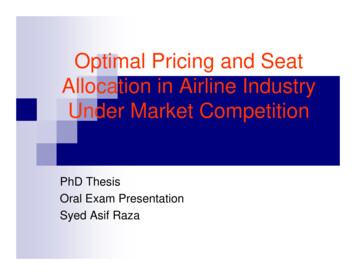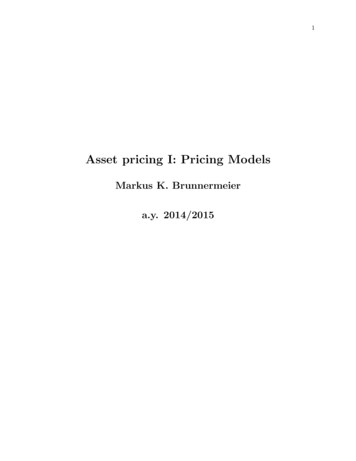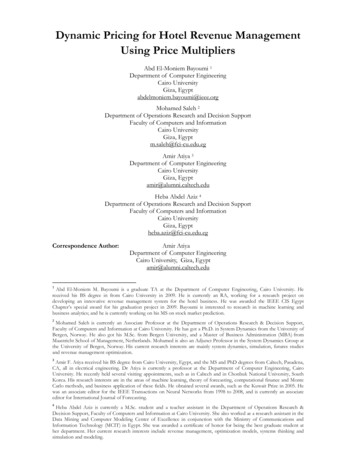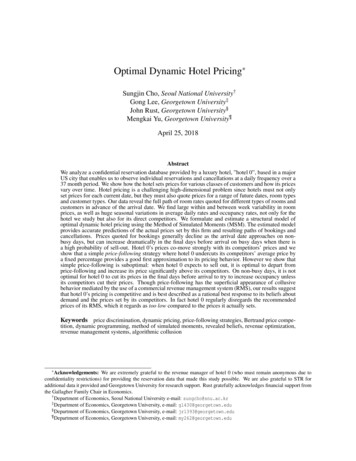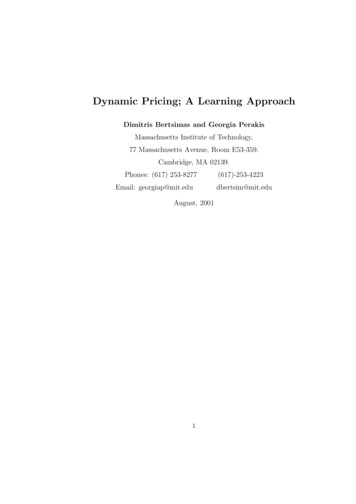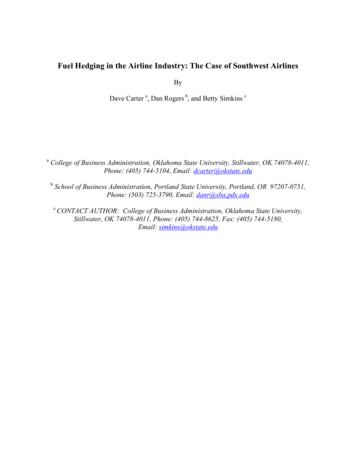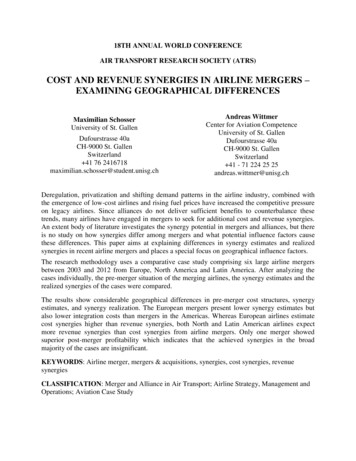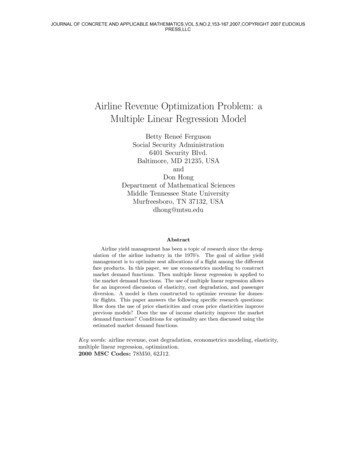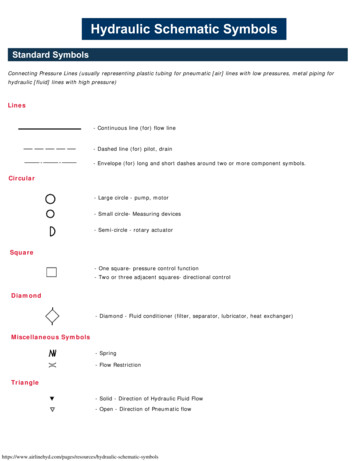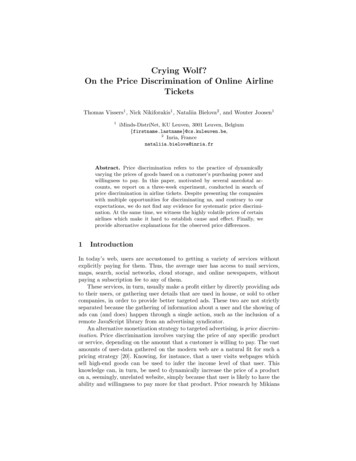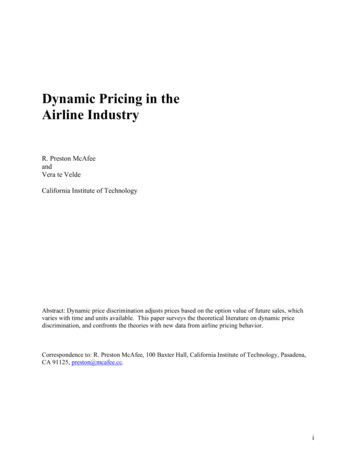
Transcription
Dynamic Pricing in theAirline IndustryR. Preston McAfeeandVera te VeldeCalifornia Institute of TechnologyAbstract: Dynamic price discrimination adjusts prices based on the option value of future sales, whichvaries with time and units available. This paper surveys the theoretical literature on dynamic pricediscrimination, and confronts the theories with new data from airline pricing behavior.Correspondence to: R. Preston McAfee, 100 Baxter Hall, California Institute of Technology, Pasadena,CA 91125, preston@mcafee.cc.i
Computerized reservation systems were developed in the 1950s to keep track of airline seat booking andfare information. Initially these were internal systems, but were soon made available to travel agents.Deregulation of airline pricing in 1978 permitted much more extensive use of the systems for economicactivity, especially pricing. The initial development of dynamically adjusted pricing is often credited toAmerican Airlines’ Robert Crandall, as a response to the rise of discount airline People’s Express in theearly 1980s. The complexity and opaqueness of airline pricing has grown over time. As a result, the“yield management” systems employed by airlines for pricing have become one of the most arcane andcomplex information systems on the planet, and one with a very large economic component. Airlinepricing represents a great challenge for modern economic analysis because it is so distant from the “lawof one price” level of analysis. This paper surveys the theoretical literature, which is mostly found inoperations research journals, develops some new theory, assesses the holes in our knowledge, anddescribes some results from a new database of airline prices.Dynamic pricing, which is also known as yield management or revenue management, is a set of pricingstrategies aimed at increasing profits. The techniques are most useful when two product characteristicsco-exist. First, the product expires at a point in time, like hotel rooms, airline flights, generatedelectricity, or time-dated (“sell before”) products. Second, capacity is fixed well in advance and can beaugmented only at a relatively high marginal cost. These characteristics create the potential for very largeswings in the opportunity cost of sale, because the opportunity cost of sale is a potential foregonesubsequent sale. The value of a unit in a shortage situation is the highest value of an unserved customer.Forecasting this value given current sales and available capacity represents dynamic pricing.Yield management techniques are reportedly quite valuable. One estimate suggests that AmericanAirlines made an extra 500 million per year based on its yield management techniques (Davis 1994).This number may be inflated for several reasons. First, it includes sales of yield management strategy toothers, as opposed to American’s own use of the techniques, although the value of American’s internaluse is put at just slightly less. Second, it incorporates “damaged good” considerations in the form ofSaturday-night stayover restrictions, as well dynamic pricing. Such restrictions facilitate static pricediscrimination, and are reasonably well-understood in other contexts (Deneckere and McAfee 1996).Nevertheless, there is little doubt that dynamic price discrimination is economically important. Thepricing systems used by most major airlines are remarkably opaque to the consumer, which is notsurprising given one estimate that American Airlines changes half a million prices per day. The impliedfrequency of price changes seems especially large given that American carries around 50,000 passengersper day.There is surprisingly little research in economics journals concerning yield management, given itsprominence in pricing in significant industries and the economic importance attached to it. This papercontributes to our understanding of yield management in five ways. First, it provides an extensive surveyof yield management research in operations research journals. Second, we explore an existing model ofGallego and van Ryzin (1994) that has a number of desirable properties, including closed form solutionsand sharp predictions, to address dynamic pricing considerations. Third, most of the literature assumesdemand takes a convenient but unlikely form. We consider the implications of constant elasticity ofdemand and demonstrate some new inequalities concerning this more standard case. We examine thiscase in the context of an efficient allocation, rather than the profit-maximizing allocation, and show thatmany of the conclusions attributed to profit-maximization are actually consequences of the dynamicefficiency. Fourth, we take a new look at dynamic pricing from the perspective of selling options. Aproblem airlines face is that late arrivals may have significantly higher value than early arrivals,suggesting the airline ought to sell two kinds of tickets: a guaranteed use ticket and a ticket that can bedelayed at the airline’s request. Fifth, we’ve collected airline pricing data and generated stylized factsabout the determinants of pricing, facilitating the evaluation of models.1
1. Airline PricingAirline pricing in the United States is opaque. It is not uncommon for one-way fares to exceed round-tripprices. The difference in price between refundable and non-refundable tickets is often a factor of four orfive. Prices change frequently, with low fares on a particular flight being available, then not, and thenavailable again. Average prices for round-trips between Phoenix and Los Angeles differ depending onwhether they originate in Los Angeles or in Phoenix. This is particularly mysterious in that the sameairlines fly these round-trips with the same set of offerings.We collected data on fares for 1,260 flights from American Airlines, Orbitz and Travelocity. Initially wecollected data on each flight eight times daily, but when American Airlines objected to the volume ofsearches, we stopped using American’s site and scaled back the other two sites to once per day per flight.As we completed some of the searches, we scaled the frequency up. Nevertheless, this represents a moreintensive look at dynamic pricing than is available from any other source to our knowledge. We will takeup our findings after presenting the theory to put the findings in perspective.We will use the following terminology. We will use price dispersion to refer to static randomization byfirms in pricing, in which each customer pays an identical price, but that price is determined by a randomprocess. We will use dynamic price discrimination to refer to charging different customers distinctmarkups over marginal cost based on the time of purchase; when such pricing is efficient (maximizes theexpected present value of the gains of trade), we’ll call it dynamic pricing rather than dynamic pricediscrimination. Restrictions like Saturday-night stayovers, that create less valuable products, involvestatic price discrimination.2. Existing LiteratureReaders seeking a general discussion of yield management are referred to Williams (1999), Brooks andButton (1994), and Kimes (1989).1 Kimes (1989) discusses situations appropriate for yield managementsolutions, particular issues involved such as demand forecasting and overbooking, solution techniques,and managerial implications of yield management systems. Brooks and Button (1994) discuss the rise ofyield management during and after deregulation of the 1970’s and 1980’s, using the shipping industry asa detailed example, and Williams (1999) discusses yield management in terms of the interactions betweenthe firm, resources, products, customers, and competitors. Talluri and van Ryzin (2004) have created athorough textbook for the student of yield management.Yield management applications in the made-to-order (MTO) manufacturing industry include Harris andPinder (1995), Sridharan (1998), and Barut and Sridharan (2004). Both MTO firms and service providerssuch as airlines face the problem of effectively utilizing a fixed capacity under uncertain or high demandin order to maximize revenue, and thus many yield management results are applicable to the MTOmanufacturing industry. However, MTO manufacturing is different on the key points of finite timehorizon and unchanging capacity. The horizon is infinite, since the factory never stops all operations at aspecific time or sets a common deadline for all activity, and the capacity is not fixed, in that as orders arecompleted, capacity is replenished. Thus, the MTO problem is more of a “stock out” problem than ayield management problem. Harris and Pinder (1995) discuss the applicability of traditional yieldmanagement to MTO manufacturing and its managerial implications and develop a relevant theoreticalframework using price classes based on unit-capacity rates. Sridharan (1998) describes the use of yieldmanagement in manufacturing situations with higher demand than capacity, discussing three methods of1A thorough literature review is contained in McGill and Van Ryzin (1999), along with a complete glossary ofterms applicable to yield management, particularly in the airline industry. This literature review is largely distinctfrom theirs and may be considered in tandem.2
increasing efficiency and revenue: capacity rationing based on price classes, increased coordinationbetween marketing and manufacturing, and subcontracting. Barut and Sridharan (2004) further explorecapacity rationing by developing a dynamic capacity apportionment procedure based on discriminating infavor of projects with a higher expected profit margin.Rather than a continuous stream of one-time manufacturing requests, Carr and Lovejoy (2000) consider anon-competitive firm that agrees to commitments of a normally distributed random annual demand. This“inverse newsvendor problem” matches a known capacity with a desired aggregate demand distribution.They also consider the effect of multiple price classes. Fen and Wang (1998) study a similar annualcapacity management problem: developing an optimal harvesting policy of a renewable resource. Theresource population is modeled as a time-dependent logistic equation with periodic coefficients, and themaximum annual-sustainable yield is determined along with the corresponding harvesting policy.The most common setting for yield management research is motivated by the airline and hotel industries.The remainder of the literature review focuses on these applications, and the rest of the paper deals withthe airline industry exclusively.Botimer (1996) and Belobaba and Wilson (1997) investigate effects of yield management external to thefirm using it. Botimer (1996) presents arguments for efficiency of yield management pricing in the airlineindustry, and Belobaba and Wilson (1997) investigate the impacts of yield management introduction incompetitive airline markets.Most yield management research, however, deals with how to actually maximize revenue. One approachis to assume that customers arrive to request a flight, state the price they will pay, and then the firmdecides whether or not to serve them. Van Slyke and Young (2000) study this situation in terms of fillinga knapsack of fixed capacity with objects of known weights (or vector weights, to fill multi-dimensionalknapsacks) and value, each type which arrives as a time-dependent Poisson process. With the goal ofmaximizing value, each object is accepted or rejected at the time of arrival. The case of equal weights isapplied to airline seat inventory control, since each customer uses one seat, and the multi-dimensionalknapsack is applied to the problem of allocating seats in a multiple origin and destination flight network.Sawaki (2003) addresses a similar question: Customers arrive throughout the continuous time horizon andstate their price and demand size, and the firm decides whether to accept the request. A semi-Markovdecision process is used, and an optimal policy and its analytical properties are found when demandarrives as a semi-Markov process.A more realistic way to treat customer price preferences with respect to the airline industry, however, is toassume that the customer’s willingness to pay is unknown when they request a ticket. Gallego and vanRyzin (1994) use intensity control theory (controlling the demand intensity with price changes) to studydynamic pricing under imperfect competition (i.e, demand is price-sensitive) and stochastic demandmodeled as a Poisson process. A closed-form solution is found for exponential demand functions and anupper-bound on revenue under general demand functions is found using a deterministic heuristic. Also,monotonicity of the optimal price policy is shown, as well as asymptotic optimality of a fixed-priceheuristic with market size. These results are then extended to allow compound Poisson demand, discreteprices, time-dependent demand, overbooking, resupply and cancellations, holding costs and discounting,and variable initial capacity.Feng and Xiao (2000a) consider the problem from the perspective of switching between a predeterminedfinite set of prices at calculated time thresholds depending on remaining time and stock. Demand is aPoisson process at each price level, and they find the optimal continuous time switching policy of anarbitrary number of either price mark-ups or mark-downs. Feng and Xiao (2000b) extend this to allowreversible price changes. They show that any subset of prices in the optimal solution is part of the3
maximum concave envelope contained in the full set of allowed prices. Feng and Gallego (2000) alsoaddress the discrete price time-threshold problem, but allow demand to be Markovian, i.e. fares anddemand are not only dependent on remaining time but also on prior sales. Chatwin (2000) additionallyallows demand (Poisson) to be time sensitive and provides the option of re-stocking at a unit cost. Zhaoand Zheng (2000) find structural properties of the optimal price-switching policy (from a compact, butnot necessa
Most yield management research, however, deals with how to actually maximize revenue. One approach is to assume that customers arrive to request a flight, state the price they will pay, and then the firm decides whether or not to serve them. Van Slyke and Young (2000) study this situation in terms of filling a knapsack of fixed capacity with objects of known weights (or vector weights, to fill .
